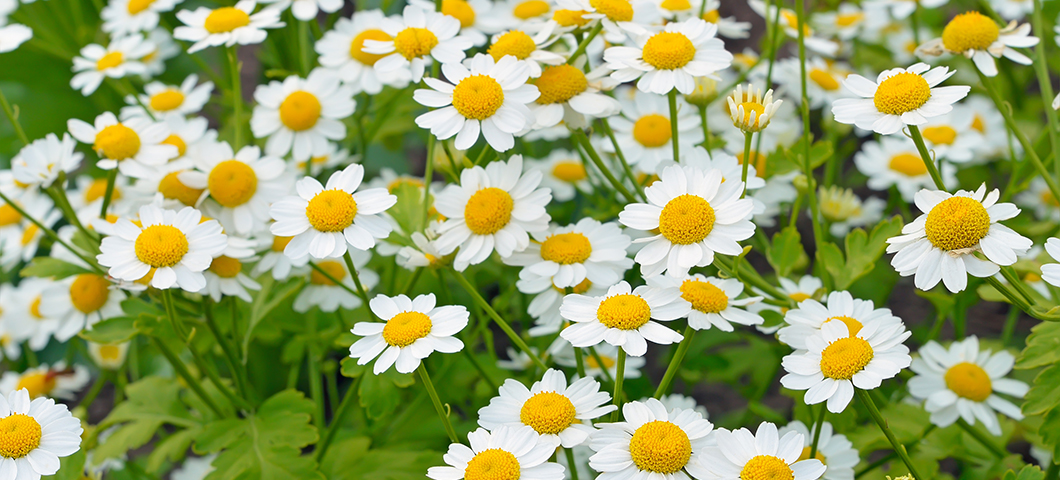Feverfew
Nancy W. Callan, Mal P. Westcott, Susan Wall-MacLane, and James B. Miller
Background
Feverfew has a long history of use as a medicinal herb. Native to southeastern Europe, feverfew is reported to be effective in relieving migraine headache. The leaf contains the active constituents and can be either used as a tea or, more commonly, as an herbal extract (Foster, 1993). Products are standardized to parthenolide, but there is a question as to whether this compound is responsible for the plant?s medicinal activity.
Feverfew is easy to grow and may be started from transplants or seeded directly in the field. The perennial plant has finely divided leaves and small white daisy-like flowers. The plant becomes woody with age and may be grown as an annual for maximum yields. The plant may be harvested before or during the bloom period, with time of harvest dependent on buyers? requirements. Several harvests per season may be possible, although late fall harvest may reduce cold hardiness. Reported yields from Australia are 2673 lb/a tea grade or 3564 lb/a manufacturing grade leaf (Rob Clark, personal communication). Foster (1993) reports that an acre should yield over a ton of dried leaf.
Research Summary
Feverfew seed was obtained from the USDA North Central Plant Introduction Station, Ames, Iowa and from Johnny's Selected Seeds, Albion, Maine. Feverfew PI596395, No. 161, was from Germany. Feverfew was sown in the greenhouse on March 30 and transplanted to the field on May 13. Six-row plots were 8 ft long with rows 18" apart and 10" between plants, with four replications. In 1998, plots were split and plants were harvested at either early bloom or full bloom,. After vigorous regrowth the plants that had been harvested at early bloom were cut again about 1 month later. The top 2/3 of the plant was removed and the plant material dried in a shaded greenhouse. Subsamples of dried plant material were rubbed through 1/4" hardware cloth to separate leaves and flowers from stems, and commercial grade harvest was calculated. Plant vigor was evaluated in July 1999. In 1999, the intention was to follow the 1998 harvesting plan, but insufficient regrowth was produced and only one harvest was done, at either early bloom or full/late bloom.
|
|
|
Dry weight (lb/a)
|
|||||
|---|---|---|---|---|---|---|---|
|
Strain
|
Harvest schedule
|
First cutting
|
Second cutting
|
Total harvest
|
|||
|
|
|
Plant tops
|
Leaves/flowers
|
Plant tops
|
Leaves/flowers
|
Plant tops
|
Leaves/flowers
|
|
Johnny's
|
Jul. 30 and Sept. 3
|
1,992
|
1,245
|
2,593
|
1,698
|
4,585 a
|
2,944 a
|
|
|
Aug. 11
|
3,085
|
2,005
|
|
|
3,085 b
|
2,005 b
|
|
# 161
|
Jul. 27 and Sept. 3
|
2,572
|
1,543
|
3,232
|
2,165
|
5,804 a
|
3,708 a
|
|
|
Aug. 7
|
3,594
|
2,327
|
|
|
3,594 b
|
2,327 b
|
Total harvest means for each harvest schedule (double vs. single cutting) followed by different letters are different by LSD (P≤0.05)
|
|
|
Dry weight (lb/acre)
|
|
|---|---|---|---|
|
Strain
|
Harvest date
|
Plant top
|
Leaves/flowers
|
|
Johnny's
|
Jul. 13
|
3,546
|
1,756
|
|
Johnny's
|
Aug. 4
|
2,919
|
1,679
|
|
|
Mean
|
3,233 a
|
1,718 a
|
|
# 161
|
Jul. 9
|
1,731
|
843
|
|
#161
|
Jul. 20
|
2,010
|
1,106
|
|
|
Mean
|
1,871 b
|
975 b
|
Means within a column followed by different letters are different by LSD (P≤0.05)
|
|
Percent of plants vigorous in 1999
|
|
|---|---|---|
|
Strain
|
One harvest in 1998
|
Two harvests in 1998
|
|
Johnny's
|
100 a
|
97 a
|
|
# 161
|
92 a
|
80 b
|
Means within a row followed by different letters are different by LSD (P≤0.05)
Productivity was highest the first year. Harvesting twice resulted in greater total yields than a single harvest (Table 1). The German strain bloomed earliest and produced a larger first harvest, but strains did not differ in total yield. Yields declined the second year (Table 2). Winter survival was a contributing factor, as overwintering mortality was greater in the German strain after two cuttings the previous year (Table 3). In 1999, yield was different between strains only in the early-harvested plots that had been cut twice the previous year. The strain from Johnny's, which exhibited better winter survival, was more productive than was the German strain after double harvest the previous year.
Feverfew can be grown as an annual for maximum productivity in colder climates. If perennial culture is desired, it is necessary to harvest early enough to allow sufficient time for regrowth in the fall.
Acknowledgments
Seed was provided by Johnny's Selected Seeds, 1 Foss Hill Road, RR1 Box 2580, Albion, ME 04910-9731
References
- Foster, S. 1993. Herbal Renaissance. Gibbs Smith, Layton UT.
- Hornok, L. 1992. Cultivation and Processing of Medicinal Plants. John Wiley and Sons, Chichester, UK.


